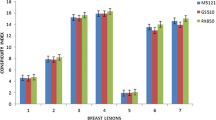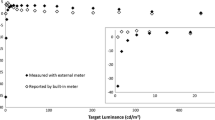Abstract
Consistent presentation of digital radiographic images at all locations within a medical center can help ensure a high level of patient care. Currently, liquid crystal displays (LCDs) are the electronic display technology of choice for viewing medical images. As the inherent luminance (and thereby perceived contrast) properties of different LCDs can vary substantially, calibration of the luminance response of these displays is required to ensure that observer perception of an image is consistent on all displays. The digital imaging and communication in medicine (DICOM) grayscale standard display function (GSDF) defines the luminance response of a display such that an observer’s perception of image contrast is consistent throughout the pixel value range of a displayed image. The main purpose of this work is to review the theoretical and practical aspects of calibration of LCDs to the GSDF. Included herein is a review of LCD technology, principles of calibration, and other practical aspects related to calibration and observer perception of images presented on LCDs. Both grayscale and color displays are considered, and the influence of ambient light on calibration and perception is discussed.









Similar content being viewed by others
References
Blume H, Roehrig H, Browne M, Lan Ji T: Comparison of the physical performance of high resolution CRT displays and films recorded by laser image printers and displayed on light-boxes and the need for a display standard. Medical Imaging IV: Image Capture and Display. SPIE 1232:97–114, 1990
Blume H: The ACR/NEMA proposal for a grey-scale display function standard. Image Display. SPIE 2707:344–360, 1996
Flynn MJ, Kanicki J, Badano A, Meyer WR: High-fidelity electronic display of digital radiographs. RadioGraphics 19:1653–1669, 1999
Samei E, Badano A, Chakraborty D, Compton K, Cornelius C, Corrigan K, Flynn MJ, Hemminger B, Hangiandreou N, Johnson J, Moxley M, Pavlicek W, Roehrig H, Rutz L, Shepard J, Uzenoff R, Wang J, Willis C. Assessment of Display Performance for Medical Imaging Systems, Report of the American Association of Physicists in Medicine (AAPM) Task Group 18. Madison, WI: Medical Physics Publishing, AAPM On-Line Report No. 03, April 2005
Barten PGJ: Contrast sensitivity of the human eye and its effects on image quality. Bellingham, WA: SPIE Press, 1999
Digital Imaging and Communications in Medicine, Part 14: Grayscale Standard Display Function, published by National Electrical Manufacturer’s Association, 2001
Roehrig H, Chawla A, Krupinski E, Fan J, Gandhi K: Why should you calibrate your display? Penetrating Radiation Systems and Applications V. SPIE 5199:181–192, 2003
Ogawa E, Shimura K: Appearance matching of radiographic images using lightness index. Image Perception and Performance. SPIE 3663:324–332, 1999
Blume H, Ho AM, Stevens F, Steven PM: Practical aspects of grayscale calibration of display systems. PACS and Integrated Medical Information Systems: Design and Evaluation. SPIE 4323:28–41, 2001
Tyler CW, Chan H, Liu L, McBride B, Kontsevich L: How to get 1786 or more grey levels from an 8-bit color monitor. Human Vision, Visual Processing, and Digital Display III. SPIE 1666:351–364, 1992
Flynn M, Tchou P: Accurate measurement of monochrome luminance palettes for the calibration of medical LCD monitors. Visualization, Image-Guided Procedures, and Display. SPIE 5029:438–448, 2003
Courtesy of F. Stevens, Planar Systems, Inc., Waltham, MA, 2006
Hecht S, Hsia Y: Relation between visual acuity and illumination. J Gen Physiol 11:255–281, 1928
Blume H, Steven PM, Cobb M, Ho AM, Stevens F, Muller S, Roehrig H, Fans J: Characterization of high-resolution liquid-crystal displays for medical images. Visualization, Image-Guided Procedures, and Display. SPIE 4681:271–292, 2002
Langer S, Fetterly K, Mandrekar J, Harmsen S, Bartholmai B, Patton C, Bishop A, McCannel C: ROC Study of four LCD displays under typical medical center lighting conditions. J Digit Imaging 19:30–40, 2006
Saunders RS, Samei E: Resolution and noise measurements of selected commercial medical displays. Med Phys 33(2):308–319, 2006
Blume H, Steven PM, Ho AM, Stevens F, Abileah A, Robinson S, Roehrig H, Fan J, Chawla A, Ghandi K: Characterization of liquid-crystal displays for medical images—Part 2. Visualization, Image-Guided Procedures, and Display. SPIE 5029:449–473, 2003
Badano A, Flynn M, Martin S, Kanicki J: Angular dependence of the luminance and contrast in medical monochrome liquid crystal displays. Med Phys 30:260–22613, 2003
Samei E, Wright SL: Viewing angle performance of medical liquid crystal displays. Med Phys 33:645–654, 2006
Fetterly K, Samei E: A photographic technique for assessing the viewing-angle performance of liquid-crystal displays. J Soc Inf Disp 14:867–872, 2006
Badano A, Fifadara DH: Goniometric and conoscopic measurements of angular display contrast for one-, three-, five-, and nine-million-pixel medical liquid crystal displays. Med Phys 31:3452–3460, 2004
Fisher AJ, Christie AW: A note on disability glare. Vision Res 5:565–571, 1965
Reading VM: Disability glare and age. Vision Res 8:207–214, 1968
Vos JJ: On the cause of disability glare and its dependence on glare angle, age and ocular pigmentation. Clin Exp Optom 86:363–370, 2003
McEntee M, Brennan P, Evanoff M, Phillps P, O Connor WT, Manning D: Optimum ambient lighting conditions for the viewing of softcopy radiological images. Image Perception, Observer Performance, and Technology Assessment. SPIE 6146:260–268, 2006
Fan J, Roehrig H, Sundareshan MK, Dallas WJ, Krupinski E: Increasing contrast resolution and decreasing spatial noise for liquid crystal displays using digital dithering. Visualization, Display, and Image-Guided Procedures. SPIE 5744:251–262, 2005
Siegel E, Krupinski E, Samei E, Flynn MJ, Andriole K, Erickson B, Thomas J, Badano A, Seibert JA, Pisano E: Digital mammography image quality-image display. Journal of American College of Radiology (in press, 2006)
Author information
Authors and Affiliations
Corresponding author
Rights and permissions
About this article
Cite this article
Fetterly, K.A., Blume, H.R., Flynn, M.J. et al. Introduction to Grayscale Calibration and Related Aspects of Medical Imaging Grade Liquid Crystal Displays. J Digit Imaging 21, 193–207 (2008). https://doi.org/10.1007/s10278-007-9022-y
Published:
Issue Date:
DOI: https://doi.org/10.1007/s10278-007-9022-y




